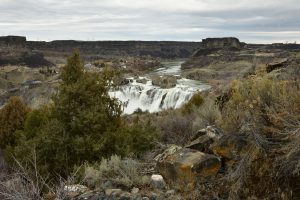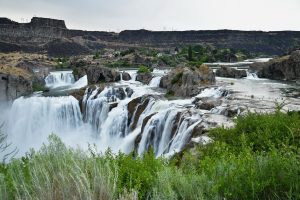
Guided Trail Home | Locations | Geology | Vegetation | Wildlife | Wellness | Photography Tips
Geology
Southern Idaho’s unique terrain is a combination of heavy volcanic activity, which deposited rocks and put the landscape together, and a huge catastrophic flood, considered to be one of the largest floods in geological history (Bonneville Flood). A prime example of the area’s unusual geology is Auger Falls, located on the Snake River just downstream from Twin Falls. Massive boulders, some as large as houses, are scattered across the area, tossed about by the flood like pieces of confetti.
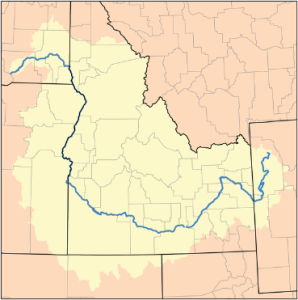
Snake River
The Snake River is the largest tributary of the Columbia River and one of the major rivers in the northwestern United States. It is an important source of irrigation water for potatoes, sugar beets, and other crops. The length of the Snake River is approximately 1,078 miles. Its drainage basin is the 10th largest among North American rivers. It covers almost 108,000 square miles throughout Wyoming, Nevada, Utah, Oregon, Washington, with the largest portion in Idaho. The Snake Rivers average flow is 54,830 cubic feet per second, and is the 9th longest river in the United States. The river originates in Yellowstone National Park in Wyoming, then passes the Teton Range, and cuts westward into the Snake River Plain. The river then leaves Idaho and travels north along the Idaho Oregon Border, from there it enters Washington and flows west to the Columbia River.
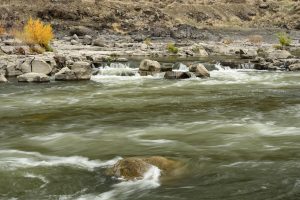
52,000 years ago, the lava from McKinney Butte dams formed Snake River near Bliss. 17,400 years ago, the catastrophic Bonneville Flood eroded narrow sections of the Snake River Canyon and deposited massive boulders in wide sections. July 24, 1993 the Bliss Landslide occurred. This changed and altered the path of the Snake River. The relentless pull of gravity and the forces of wind, water and ice collectivity wore down the Earth’s surface creating the beautiful scenery we enjoy today.
Rhyolite
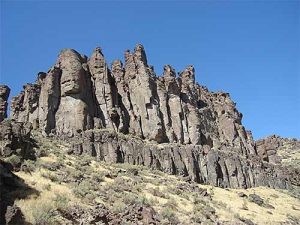
Two fundamental types of volcanism were involved in the formation of the Owyhee Plateau and the Snake River Plain. The first was the eruption of Rhyolite from magmas with the same composition as granite, being rich in silica and alkali elements, these magmas were mainly materials melted out of the Earth’s crust. The second type of volcanism was the eruption of basalt. These magmas came from deeper in the Earth, from the mantle, and were hotter than the rhyolite magmas.
Rhyolite is an extrusive igneous rock with very high silica content. It is usually pink or gray in color with grains so small that they are difficult to observe without a hand lens. Rhyolite is made up of quartz, plagioclase, and sanidine, with minor amounts of hornblende and biotite. Trapped gases often produce cavities in the rock that often contain crystals, opal, or glassy materials.
Many Rhyolites form from granitic magma that has partially cooled in the subsurface. When these magmas erupt, a rock with two-grain sizes can form. The large crystals that formed beneath the surface are called phenocrysts, and the small crystals formed at the surface are called ground mass. Rhyolite usually forms in continental or continent-margin volcanic eruptions where granitic magma reaches the surface. Rhyolite is rarely produced in oceanic eruptions.
Basalt
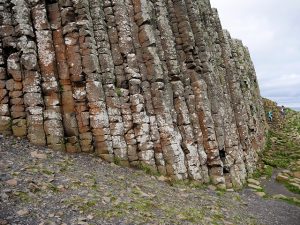
Basalt is a dark colored, igneous rock composed mainly of plagioclase and pyroxene minerals. Basalt underlines more of the Earth’s surface than any other rock. Most areas within the Earth’s ocean basins are underlain by basalts. Most of the basalt found on Earth is produced in just three rock-forming environments: oceanic divergent boundaries, oceanic hotspots, and hotspots beneath continents. Another environment where basalt is formed is a continental environment. A mantle plume delivers enormous amounts of basaltic lava through the continental crust and up to the Earth’s surface. This method has produced the largest flow of basalt on land. Basalt is mostly used for construction projects. Basalt is also used for road base, concrete, and pavement. Basalt can also be polished for use as floor tiles.
Breccia (pronounced Bretch-ee-uh)
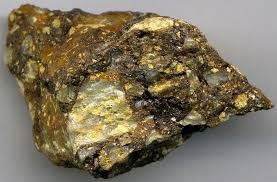
This rock formation is made of angular rock fragments randomly arranged and loosely cemented together in a yellowish matrix. There are many compositions of breccia. The composition is determined by the mineral material and rock that the angular fragments were produced from. This material ranges in size from boulders to sand grains. Angular boulders of breccia can be found along the canyon walls in various sizes directly above rhyolite, but its thickness varies. Breccia represents the break-up and erosion of the caldera possibly due to landslides. This rock occurs worldwide and has been found on the Moon and Mars. The rock is used as architectural stone for paving stones, building stones, tiles, windowsills, and interior building veneers.

